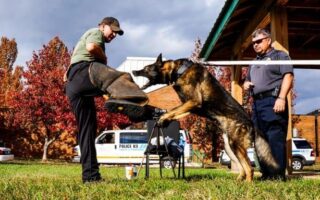Unleashed Potential: The Art of Off-Leash Dog Training
In a world bustling with urban chaos and the hum of daily life, the bond between humans and dogs flourishes in the serene dance of freedom and trust. Off-leash dog training is not merely a skill; it’s an art form that represents the pinnacle of canine companionship. Imagine a sun-drenched park where your furry friend joyfully races across the field, unshackled from the limitations of a leash, yet wholly attuned to your presence. This article delves into the nuances of off-leash training, exploring its benefits, key techniques, and the profound connection it fosters. Whether you’re an experienced trainer or a new pup parent eager to forge a deeper relationship, join us as we embark on a journey to unlock the full potential of your canine companion, embracing the freedom of off-leash adventures.
Table of Contents
- Understanding the Principles of Off Leash Dog Training
- Building a Strong Foundation: Essential Skills for Freedom
- Overcoming Common Challenges in Off Leash Training
- Safety First: Tips for a Successful Off Leash Experience
- Q&A
- Concluding Remarks
Understanding the Principles of Off Leash Dog Training
To successfully implement off-leash dog training, it’s crucial to first build a solid foundation based on trust and communication. Establishing a strong bond with your dog allows for a more enjoyable training experience. Utilizing positive reinforcement techniques, such as treats and praise, encourages desired behaviors while reinforcing your dog’s trust in your commands. Focus on teaching essential commands like “come,” “stay,” and “leave it.” These will serve as the cornerstones for your dog to feel secure and responsive even in open spaces. A calm and consistent approach is key; dogs thrive in environments where they understand what is expected of them.
Another significant aspect to consider is the environment in which you train. Begin in a familiar, low-distraction area before gradually introducing your dog to more stimulating surroundings. This phased approach helps in cementing their understanding of the commands in various settings. Additionally, ensure that your dog has a strong recall rate before allowing them off the leash. Here are some guiding principles to keep in mind:
- Consistency: Use the same commands and signals regularly.
- Gradual Progression: Start with short distances, gradually increasing as your dog improves.
- Patience: Training may take time, but persistence is key.
- Distraction Training: Practice in environments with distractions to strengthen focus.
Implementing these foundational elements will contribute significantly to your success. Below is a simple overview of desirable training timelines:
| Week | Focus Area |
|---|---|
| 1 | Establishing basic commands |
| 2 | Short-distance recall training |
| 3 | Distraction training in familiar settings |
| 4+ | Gradual off-leash experiences in safe areas |
Building a Strong Foundation: Essential Skills for Freedom
When embarking on the journey of off-leash dog training, cultivating a variety of essential skills is crucial for both dogs and their handlers. These skills create a strong foundation that empowers dogs to thrive in a more liberated environment. Key competencies include:
- Reliability in Recall: Ensuring your dog comes back when called, irrespective of distractions.
- Impulse Control: Teaching your dog to resist temptations and maintain focus.
- Socialization: Exposing your dog to various environments and other animals to develop good behavior.
- Communication: Establishing clear signals that facilitate an understanding between you and your dog.
To effectively implement these skills, a structured training approach is vital. Utilizing positive reinforcement can significantly enhance your dog’s learning experience. Regular practice sessions in varied settings will reinforce these skills. Here’s a simple overview of training elements and their benefits:
| Training Element | Benefits |
|---|---|
| Recall | Enhances safety and freedom, reduces anxiety. |
| Impulse Control | Promotes patience and better decision-making. |
| Socialization | Reduces fear and aggression, builds confidence. |
| Communication | Strengthens the bond, improves understanding. |
Overcoming Common Challenges in Off Leash Training
Training your dog to be off-leash can uncover a range of obstacles, but understanding these challenges is half the battle. One common issue is the distraction of other animals or people. To combat this, gradually introduce your dog to controlled environments where they can encounter distractions at a manageable level. This can include quiet parks or backyards with friends and their dogs, allowing your pup to learn how to focus on you, even when tempted to explore. Positive reinforcement—rewarding them for staying attentive despite these distractions—can significantly improve their ability to remain focused on commands.
Another frequent hurdle is the inconsistent recall during training. Dogs are naturally curious, and their instincts can lead them away from you. To enhance their recall abilities, incorporate the use of engaging commands and treats. Consider the following tactics: use high-value treats that your dog finds irresistible, vary your rewards to keep them guessing, and practice short, fun recall games to reinforce this vital skill. Here’s a quick breakdown of effective recall training techniques:
| Technique | Description |
|---|---|
| Engage & Redirect | Distract and redirect your dog’s attention when they stray. |
| Mark & Reward | Use a distinct word when they return to you and reward immediately. |
| Gradual Increase | Slowly increase the distance of your recalls as they become reliable. |
Safety First: Tips for a Successful Off Leash Experience
When embarking on an off-leash adventure with your furry companion, prioritizing safety ensures a smooth experience for both of you. Establish clear signals and commands before you let your dog roam freely. Reinforce basic training commands, such as “come,” “stay,” and “leave it,” during your practice sessions. Encourage good behavior by rewarding your dog with treats or praise when they respond correctly. Utilize a long leash or a training lead to facilitate a controlled environment while gradually introducing off-leash elements.
Being prepared for various scenarios can significantly enhance your outings. Consider the following tips to maintain safety and enjoyment:
- Select a secure area: Choose a dog park or a place where dogs are permitted off-leash
- Monitor surroundings: Keep an eye out for potential hazards, such as wildlife, busy roads, or other dogs
- Stay visible: Make sure your dog is wearing a bright collar or harness, so they can be easily spotted
- Hydration matters: Always have fresh water on hand for breaks, especially during warm weather
| Essential Gear | Purpose |
|---|---|
| Long Leash | For gradual independence and training |
| Collapsible Water Bowl | To keep your dog hydrated |
| Treat Pouch | To reward good behavior |
| First Aid Kit | For treating minor injuries on the spot |
Q&A
Q&A: Understanding Off-Leash Dog Training
Q1: What is off-leash dog training?
A1: Off-leash dog training is a specialized approach where dogs are trained to be obedient and responsive to commands without a leash. The goal is to enhance the dog’s freedom to explore while ensuring they maintain control and can respond to their owner’s commands reliably, regardless of the distractions around them.
Q2: Why is off-leash training important?
A2: Off-leash training is important for several reasons. It fosters a strong bond between the dog and owner, promotes greater independence and confidence in dogs, and allows for more freedom during activities like hiking or playing in open spaces. Additionally, well-trained off-leash dogs are often safer, as they are less likely to dash into traffic or engage in risky behavior when they know how to respond to commands.
Q3: At what age should I start training my dog to be off-leash?
A3: There’s no one-size-fits-all answer, but starting training around six months is generally ideal. By this age, dogs are usually mature enough to understand basic commands and can begin to grasp the concept of off-leash freedom. However, each dog is unique; some may require more time to develop reliability. It’s essential to assess your dog’s temperament and readiness before beginning off-leash training.
Q4: What basic commands should my dog master before going off-leash?
A4: Before embracing the off-leash lifestyle, your dog should be proficient in essential commands like “sit,” “stay,” “come,” “down,” and “leave it.” Mastery of these commands ensures your dog can respond to your cues promptly, reducing the risk of accidents or misunderstandings in uncontrolled environments.
Q5: How can I ensure my dog is ready for off-leash time?
A5: Ensuring your dog is ready for off-leash activities consists of consistent training sessions in various environments. Start in familiar, low-distraction areas and gradually introduce them to busier environments. Check your dog’s recall ability and assess how they react to other dogs and people. If they consistently respond to commands in varied settings, they’re likely ready for off-leash excursions.
Q6: What should I do if my dog refuses to follow commands off-leash?
A6: If your dog isn’t following commands while off-leash, it may indicate gaps in training or familiarity with surroundings. Revisit basic training in a controlled environment before gradually increasing distractions. Building positive reinforcement strategies, such as treats or playtime, can also encourage compliance. Patience and persistence are key; never punish the dog, as that can damage the trust you’ve built together.
Q7: Are there any safety concerns with off-leash training?
A7: Yes, there are safety concerns to consider. Always assess the environment: choose safe spaces like fenced areas or designated dog parks. Watch for hazards such as wildlife, traffic, or aggressive dogs. Also, ensure that your dog is socialized with other pets and people, and keep a keen eye on their body language during off-leash interactions to prevent potential conflicts.
Q8: Can any dog be trained to be off-leash?
A8: While many dogs can be trained to go off-leash, individual temperament and breed characteristics play a significant role in their suitability. Highly energetic or prey-driven breeds may require more rigorous training and control, while some dogs might thrive and excel in off-leash situations. It’s essential to evaluate your dog’s unique personality and capabilities before deciding on off-leash training.
Q9: How can I incorporate off-leash training into daily activities?
A9: Incorporating off-leash training into daily routines can be seamless and fun. Take advantage of safe parks or open spaces where you can practice commands in quiet areas before gradually facing distractions. Mix in games like fetch or hide-and-seek, where recall is essential, to reinforce training while ensuring your dog’s playtime remains enjoyable.
Q10: What resources are available for off-leash dog training?
A10: There are plenty of resources available for off-leash dog training, including books, online courses, and professional trainers. Many local dog training schools offer specialized classes focused on off-leash techniques. Joining online communities and forums can also provide support and shared experiences from other dog owners who have journeyed the off-leash path.
—
Remember, off-leash training is as much an art as it is a skill; it requires time, commitment, and a little bit of creativity. With patience and practice, both you and your furry friend can enjoy the freedom and joy that come with being off-leash!
Concluding Remarks
off-leash dog training is more than just a set of commands; it’s a journey of trust, understanding, and companionship between you and your canine friend. By investing time and effort into this training, you’re not just granting your dog the freedom to explore the world around them, but also enriching your shared experiences. As you embark on this adventure, remember that patience and consistency are your greatest allies. With each successful recall, your bond grows stronger, leading to countless joyful moments and unforgettable memories in the great outdoors. So, leash up that enthusiasm, take a deep breath, and step into the world of off-leash training — where discovery awaits for both you and your furry companion. Happy training!



